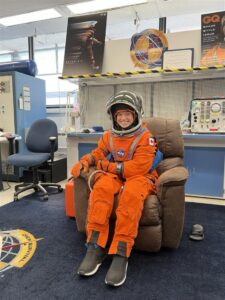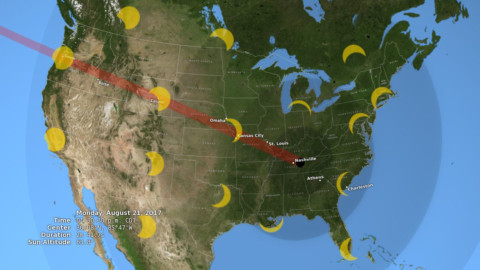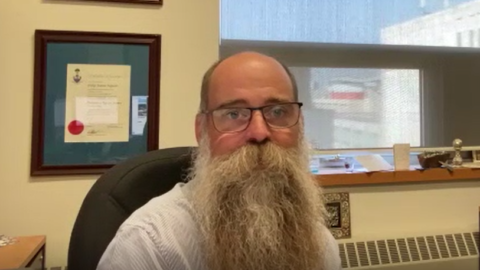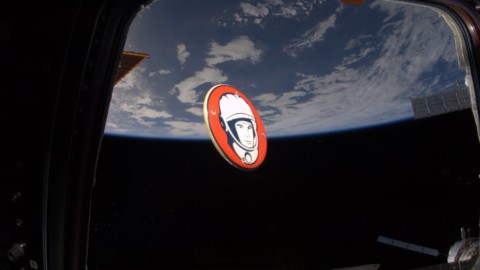CSA astronaut Jenni Gibbons (Credit: Canadian Space Agency)
Interviewed by: Joshua Sorell
Q: Please tell us about yourself. Who are you and what do you do?
A: Thank you for having me with you. I’m Jenni Gibbons. I’m an astronaut with the Canadian Space Agency. I wish I could be with you in person, but I am on the phone with you from Houston, Texas. I work pretty much full time down here at Johnson Space Center.
Q: Did you grow up in Calgary, Canada?
A: I did originally, I’m from Calgary (Canada). We moved around a little bit when I was younger, but I was born in Calgary and now much of my family lives in British Columbia. When I am lucky enough to come back and spend time in Canada, I go over there to see them or spend time at the Space Agency in Saint-Hubert.
Q: Can you play an instrument?
A: A long time ago I used to play the trumpet. it’s been years since I played, but I used to really love it.
Q: Can you tell us about the Artemis missions and what they are?
A: Absolutely. We’re all very familiar with the Apollo missions. Those wonderful missions that took us to the Moon for the first time 50 years ago. Artemis is the next generation of, I would say, deeper space exploration. It’s taking that groundbreaking science that we gained from Apollo, and I think of it as a mix of that Apollo plus the International Space Station program, which is, just by nature, a collaboration by so many different partners on Earth that’s made it much more sustainable. If you’d like to think of Artemis as kind of a Venn diagram of those two things. The groundbreaking science of Apollo returning to the Moon, but also with the international component, that’s the best way to describe Artemis.
It’s a set of return to the Moon missions. The first crewed mission will be Artemis II, which Canada is fortunate enough to have a seat on that’s filled by Jeremy Hansen. And that is going to be, I would argue, the most critically important human mission, in space, in over 50 years. It’s going to be a lunar flyby and we’re going to learn an enormous amount from that.
Q: You are the backup for the Artemis II mission for Jeremy Hansen. How did you learn that you were going to be a backup for that mission?
A: I learned kind of behind the scenes a little bit before it was publicly announced, and I’d kind of quietly been doing some training and some suit fit activities for that. I learned through a discussion with my colleagues and some work with Jeremy. All of them had been very, very supportive throughout that process, but since it’s been announced, I’ve really gotten started with all of it, it’s been great.

Astronaut Jenni Gibbons Artemis II suit fitting (Credit: Canadian Space Agency)
Q: Can you tell us about a bit of the astronaut training, like what you’re going through to train to be an astronaut?
A: When I first arrived in Houston, that was 2017, we undergo what’s called our basic training or our astronaut candidate program. And that takes two years, and it fully qualifies you to fly in space, mostly for the International Space Station. You learn how to do spacewalks, you learn Russian, you learn how to fix and maintain the systems on the International Space Station, and you learn how to work the space station robotic arm, Canadarm2. Joshua Kutryk and I both completed that, Joshua Kutryk being my colleague who I was selected with. Since then, we’ve been doing various mission support activities, and now that we’re both assigned: him to the International Space Station, and I’m assigned as the Artemis II backup, my focus has shifted more to preparing for that mission to the Moon.
Right now, I’m involved with developing the procedures that the crew is going to need on that, just under, two week-long mission. I’m developing a lot of the crew training. For future Artemis crews, I’m sitting in simulations with the ground team, helping them prepare for troubleshooting and problem solving for any issue that the crew or the capsule might encounter.
I’m preparing for recovery tests for the capsule after they splash down, and I’m also training myself, so not only am I training to be a crew member, should there be a situation where I need to, I need to step in for any reason. I’ll be prepared to do that to support the crew however they need it.
I’ll also be acting as Capcom, so the voice in Mission Control, which speaks to the crew when they are on their mission around the Moon. Joshua Kutryk and I both have a lot of experience being a capsule communicator for the Space Station. We sit in Mission Control and support that crew with whatever they’re doing and whatever they need, we’ve both done that for regular operations and we’ve both also done that for spacewalks. Being what’s called a ground IV, that stands for intravehicular officer, the ground IV act as the communicator for a spacewalk. And we’ve both done that as that role as well.
Q: There was a delay, just announced for the Artemis mission this last week, has that affected your training at all?
A: Not really. I mean, we are so far out, it means that the goal that we’re all working toward has shifted, but we all signed up for this being very aware that it was a new program. It’s a pretty complicated mission, a very complicated mission, more complicated than we’ve done in a long time. To prepare for that, we’re going to have to do a lot of additional work. All the partners will not commit to doing that until we really are ready to go because it is the first crewed flight of that capsule.
We are aware that something like that could come along and preparing for it. So, of course, kind of like the finish line has moved out, but the team has stayed focused. I wouldn’t say that there is any sort of change in pace or, change in attitude from everyone. Everyone’s still really focused on the mission and feeling excited and prepared and just trying to get everything done, making sure that it’s safe. No big impacts beyond that change, like a shift out in focus. we’re just continuing.
Q: Could you tell us about safety for the Artemis II trip?
A: Artemis I was an uncrewed mission, a demonstration flight, and a lot of the hardware performed incredibly well. It was a very successful demonstration flight. Artemis II will be the first crew demonstration of the Orion capsule and a lot of the hardware is undergoing testing and the priority above everything else is going to be crew safety. It’s at the forefront of everybody’s mind as they’re undergoing the development and all the logistics for this work.
That’s a big part of, as NASA said in the press conference, of the timeline to Artemis II and beyond. It’s just we’re not going to go before it’s ready. It really is the most important thing. NASA is applying all their risk management work like they’ve done previously. There really is such an excellent culture of thoroughness and preparedness at NASA, which has been driven by past lessons learned and is necessary for missions where there is so much inherent risk.
Q: What methods are there to keep you safe or an astronaut safe from radiation when they’re going around the Moon?
A: First, our radiation is tracked. We have a pretty rigorous medical program where we have annual medicals for every astronaut that is willing to participate who has ever been to space. And there are yearly medicals after you retire as well. There’s a big database where we’re collecting information for the effect of spaceflight and radiation on the human body. Your individual dose and risk are tracked. Tracked based on your space flight and your exposure along the way. It’s something that the team is very focused on keeping us safe throughout.
It’s a risk that a lot of us are exposed to and willing to accept. Artemis I had some interesting test possibilities of a vest to keep astronauts safe from radiation on one of the dummies that was flown. They’re looking into novel ways to keep astronauts safe. The exposure is much higher than it is in the International Space Station because we’re out of the magnetosphere of the Earth so it’s ongoing work, and it’s something that the teams are looking at.
Q: Okay, so can you talk to us about fire safety? I know you studied fire propagation in zero g. Could you tell us about that and how you protect against fire on a space mission?
A: When we look at fire safety in general, the main concern is the materials that we’re using. Everything that flies up there must pass fire safety tests and be rated to be up there. Then crew is trained to respond. A fire is one of the big emergencies that we train to protect both ourselves and our vehicle, should it ever happen on the International Space Station.
There are combustion experiments in microgravity environments, whether they’re on parabolic flights or drop towers, or even on the International Space Station. The first thing you’ll notice is that the flame has a different shape than it does here on Earth. We always think about hot things being lighter, so they rise here, but there’s no stratification based on that density in a zero G environment or microgravity environment. The flame appears spherical; it’s a cool looking flame.
Q: Is there anything else you would like to add?
A: I know that you have a very space savvy audience. I want to add an emphasis on how important space is for Canadians. That’s a message I always try and talk about. I think for a country like ours, that’s so enormously vast and so diverse, I just want to talk about how critical space exploration and the space agency and space activities are because it really is one of the only ways that we get to monitor the health of our country on our planet. When we’re looking at things like changes in permafrost or ice sheets or the health of our forests, to how natural disasters are affecting our cities and our people, to food security, all of those either Earth observation or let’s say the distribution of food. All of that is related to space exploration and entirely enabled by activities in space. I would hope that people have that connection that they’ve made. It’s not necessarily an obvious one unless they’ve spent some time thinking about it. I guess I would just like to talk about encouraging Canadians to find out more about how their daily lives are impacted by space science and space exploration and what it brings us. We don’t have to look too far, and you can just look at your breakfast table and understand where your food comes from, or the technology that enables your phone or your GPS, to recently the need for remote medical care during the pandemic. That’s not too dissimilar an issue for remote communities as medical care for astronauts on longer term space missions. Especially deep space missions if we think about something like Artemis. I wanted to mention as well how important space is for Canadians and of course they’re curious about it and I absolutely love that about our country in general.
I would love to learn more about remote healthcare. Medicine is not my area of expertise; it is not my background. I’m a mechanical engineer by training and then I got into combustion. It’s something where I really think the space agency could make a big impact. For all these remote regions that we have in Canada providing medical supplies and we have some cool projects, both the Health Beyond initiative and then the Connected Care modules. As well at the space agency there are just cool initiatives that students can also get involved with, we have a lot of outreach activities. It’s not something that is my area of expertise or my wheelhouse. I’m certainly interested in it, and I think it’s one of the places that Canada can make a huge impact in both the space world, but also at home.
Thank you, Jenni, for the great interview and meeting with me today.






